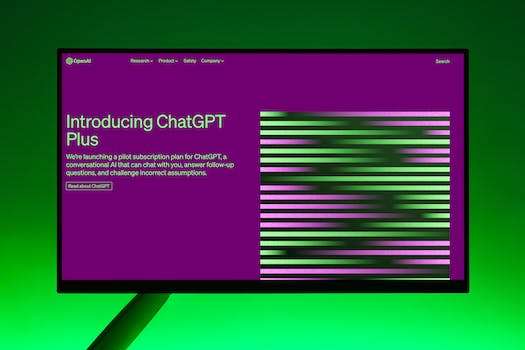creating a chatbot with your website data can be a great way to engage with your customers and provide them with a more personalized experience. Chatbots are becoming increasingly popular as they can provide customers with quick and easy access to information, as well as provide a more interactive experience. This step-by-step guide will walk you through the process of creating a chatbot (ChatGPT) with your website data. You will learn how to set up the chatbot, how to integrate it with your website, and how to use it to engage with your customers. With this guide, you will be able to create a chatbot that is tailored to your website and provides your customers with a more personalized experience.
Take the first step towards creating a Chatbot (ChatGPT) with your website data by following this step-by-step guide! Click here to get started now!
How to Create a Chatbot (ChatGPT) with Your Website Data: A Step-by-Step Guide
Introduction
Chatbots are becoming increasingly popular as a way to provide customer service and support. They can be used to answer customer questions, provide product information, and even help with sales. ChatGPT is a powerful chatbot platform that allows you to create a chatbot with your website data. This step-by-step guide will show you how to create a ChatGPT chatbot with your website data.
Step 1: Sign Up for a ChatGPT Account
The first step is to sign up for a ChatGPT account. You can do this by visiting the ChatGPT website and clicking the “Sign Up” button. You will need to provide your name, email address, and a password. Once you have completed the sign-up process, you will be able to log in to your account.
Step 2: Connect Your website Data
Once you have logged in to your account, you will need to connect your website data. This can be done by clicking the “Connect” button and then selecting the type of data you want to connect. You can connect data from your website, such as product information, customer reviews, and FAQs.
Step 3: Create Your chatbot
Once you have connected your website data, you can begin creating your chatbot. You can do this by clicking the “Create” button and then selecting the type of chatbot you want to create. You can choose from a variety of templates, such as customer service, sales, and product information.
Step 4: Train Your chatbot
Once you have created your chatbot, you will need to train it. This can be done by providing it with sample conversations and then allowing it to learn from them. You can also provide it with additional data, such as customer reviews and FAQs, to help it become more accurate.
Step 5: Test Your chatbot
Once you have trained your chatbot, you will need to test it. This can be done by having it interact with real customers and then evaluating its performance. You can also use the ChatGPT dashboard to monitor the performance of your chatbot and make any necessary adjustments.
Conclusion
creating a ChatGPT chatbot with your website data is a great way to provide customer service and support. By following the steps outlined in this guide, you can easily create a chatbot that is tailored to your website data. With the right training and testing, your chatbot can become an invaluable asset to your business.
What Are the Benefits of Creating a Chatbot (ChatGPT) with Your Website Data?
creating a chatbot (ChatGPT) with your website data can provide numerous benefits for your business. Firstly, ChatGPT can help to automate customer service tasks, such as answering frequently asked questions, providing product information, and helping customers with their orders. This can help to reduce the amount of time spent on customer service tasks, freeing up resources to focus on other areas of the business.
Secondly, ChatGPT can help to improve customer engagement. By providing customers with a more interactive and personalized experience, ChatGPT can help to build customer loyalty and trust. This can lead to increased customer satisfaction and higher conversion rates.
Thirdly, ChatGPT can help to improve the accuracy of customer data. By using your website data, ChatGPT can provide customers with more accurate and up-to-date information. This can help to reduce customer confusion and improve customer service.
Finally, ChatGPT can help to improve the efficiency of your website. By automating customer service tasks, ChatGPT can help to reduce the amount of time spent on customer service tasks, freeing up resources to focus on other areas of the business. This can help to improve the overall efficiency of your website.
Overall, creating a chatbot (ChatGPT) with your website data can provide numerous benefits for your business. By automating customer service tasks, improving customer engagement, improving the accuracy of customer data, and improving the efficiency of your website, ChatGPT can help to improve the overall performance of your business.
How to Use Your Website Data to Train Your Chatbot (ChatGPT)

Chatbots are becoming increasingly popular as a way to provide customer service and support. They can be used to answer customer questions, provide product information, and even help with sales. However, in order to be effective, chatbots need to be trained to understand the language and context of the conversations they are having.
One way to train your chatbot is to use your website data. By analyzing the conversations that take place on your website, you can gain insights into the types of questions customers are asking and the language they are using. This data can then be used to train your chatbot, such as ChatGPT, to better understand the conversations it is having.
To use your website data to train your chatbot, you will first need to collect the data. This can be done by using a web scraping tool to extract the conversations from your website. Once you have the data, you can then use it to train your chatbot.
For example, you can use the data to create a training dataset for your chatbot. This dataset should include conversations that are similar to the ones that take place on your website. You can also use the data to create a set of rules that your chatbot should follow when responding to customer inquiries.
Once you have created the training dataset and rules, you can then use them to train your chatbot. ChatGPT is a powerful chatbot platform that allows you to easily train your chatbot using your website data. It provides a range of tools and features that make it easy to create a training dataset and set of rules for your chatbot.
By using your website data to train your chatbot, you can ensure that it is better able to understand the conversations it is having and provide more accurate responses. This can help to improve customer satisfaction and increase sales.
What Are the Challenges of Creating a Chatbot (ChatGPT) with Your Website Data?
creating a chatbot (ChatGPT) with website data can be a challenging task. Firstly, the data must be collected and organized in a way that is suitable for the chatbot. This includes ensuring that the data is accurate, up-to-date, and relevant to the chatbot’s purpose. Additionally, the data must be formatted in a way that is compatible with the chatbot’s programming language.
Another challenge is creating the chatbot’s natural language processing (NLP) capabilities. This requires the chatbot to be able to understand and respond to user input in a natural way. This can be difficult to achieve, as the chatbot must be able to interpret the user’s intent and respond accordingly.
Finally, the chatbot must be tested and evaluated to ensure that it is functioning correctly. This includes testing the chatbot’s accuracy, speed, and ability to respond to user input. Additionally, the chatbot must be monitored to ensure that it is not making any mistakes or providing incorrect information.
Overall, creating a chatbot (ChatGPT) with website data can be a challenging task. However, with the right data, programming language, and NLP capabilities, it is possible to create a successful chatbot.
How to Optimize Your Chatbot (ChatGPT) with Your Website Data
Chatbots are becoming increasingly popular as a way to provide customer service and support. ChatGPT is a powerful chatbot platform that allows businesses to create custom chatbots to interact with customers. However, in order to get the most out of your ChatGPT chatbot, it is important to optimize it with your website data. Here are some tips for optimizing your ChatGPT chatbot with your website data:
1. Analyze Your website Data: Before you can optimize your ChatGPT chatbot, you need to analyze your website data. This includes looking at the types of questions customers are asking, the types of responses they are getting, and the overall customer experience. This will help you identify areas where your chatbot could be improved.
2. Identify Keywords: Once you have analyzed your website data, you can start to identify keywords that customers are using when they interact with your chatbot. This will help you create more targeted responses and ensure that your chatbot is providing the best possible customer experience.
3. Create Custom Responses: Once you have identified the keywords customers are using, you can create custom responses for each keyword. This will help your chatbot provide more accurate and helpful responses to customers.
4. Monitor Performance: Once you have created custom responses, it is important to monitor the performance of your chatbot. This will help you identify areas where your chatbot could be improved and make adjustments as needed.
By following these tips, you can optimize your ChatGPT chatbot with your website data and ensure that your customers are getting the best possible customer experience. With the right optimization, your chatbot can become an invaluable asset to your business.
What Are the Best Practices for Creating a Chatbot (ChatGPT) with Your Website Data?
1. Start by understanding the purpose of your chatbot. What do you want it to do? What kind of conversations do you want it to have with your website visitors?
2. Create a list of topics and questions that your chatbot should be able to answer. This will help you create a more natural conversation flow.
3. Use natural language processing (NLP) to create a conversational interface. This will help your chatbot understand the context of the conversation and respond accordingly.
4. Use your website data to create a knowledge base for your chatbot. This will help it answer questions more accurately.
5. Test your chatbot regularly to ensure it is responding correctly and providing accurate information.
6. Monitor user feedback and use it to improve your chatbot.
7. Make sure your chatbot is secure and compliant with data privacy regulations.
8. Provide a way for users to opt-out of conversations with your chatbot.
9. Make sure your chatbot is accessible to all users, including those with disabilities.
10. Provide a way for users to contact a human if they need help.
Q&A
Q1: What is a chatbot?
A1: A chatbot is a computer program that simulates conversation with human users through text or voice interactions. Chatbots are used in a variety of applications, such as customer service, marketing, and entertainment.
Q2: What is ChatGPT?
A2: ChatGPT is a chatbot platform that enables developers to create custom chatbots using their own website data. It uses natural language processing (NLP) and machine learning (ML) to understand user input and generate responses.
Q3: How do I create a chatbot with ChatGPT?
A3: To create a chatbot with ChatGPT, you will need to create an account and then upload your website data. Once your data is uploaded, you can use the platform’s tools to create your chatbot.
Q4: What types of data can I use to create a chatbot?
A4: You can use any type of data that is relevant to your website, such as customer service logs, product information, FAQs, and more.
Q5: How do I train my chatbot?
A5: You can train your chatbot by providing it with examples of conversations and responses. The more examples you provide, the better your chatbot will be able to understand user input and generate appropriate responses.
Q6: What are the benefits of using ChatGPT?
A6: ChatGPT offers a number of benefits, including the ability to quickly create custom chatbots, the ability to use your own website data, and the ability to easily train your chatbot. Additionally, ChatGPT is easy to use and requires no coding knowledge.
Conclusion
creating a chatbot (ChatGPT) with Your website Data: A Step-by-Step Guide is a great resource for anyone looking to create a chatbot for their website. It provides a comprehensive overview of the process, from gathering data to training the chatbot, and provides detailed instructions for each step. With this guide, anyone can create a chatbot that is tailored to their website and can provide a more personalized experience for their customers.













